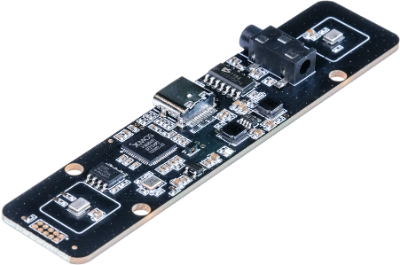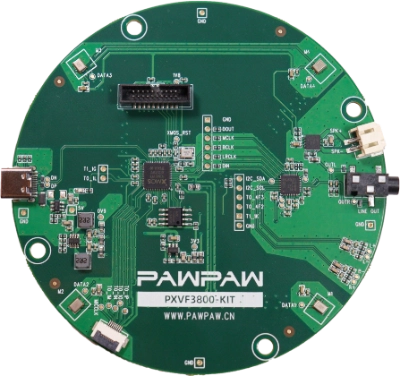
In-Depth Exploration of Microphone Array Technology
Microphone array technology has become integral to various aspects of our lives, offering unparalleled benefits in communication systems, audio recording, and sound source localization. This article will dive into the fundamental concepts, working principles, types, and classifications of microphone arrays, and discuss their applications across different fields and future developmental trends.
Fundamental Concepts of Microphone Arrays
What is a Microphone Array
A Microphone Array is a system consisting of multiple microphones arranged in a specific geometric pattern. These microphones work together to gather sound signals from different directions. Through signal processing techniques, they can enhance target sounds, suppress noise, and capture and recognize sound accurately.
Microphone arrays are widely used in various settings, such as conference systems, voice assistants in smart homes, video conferencing equipment, hearing aids, and voice control systems in autonomous vehicles. The broad application of this technology is due to its exceptional performance, functionality, and problem-solving capabilities.
Historical Development of Microphone Arrays
The origins of microphone array technology date back to the early 20th century, initially used in radar and sonar for reconnaissance and underwater object detection. With advancements in digital signal processing technology and increased computational power, microphone array technology gradually transitioned into civilian use.
By the 2000s, the proliferation of smart devices expanded the application of microphone arrays in speech recognition, control, and other areas, driving consumer demand for high-quality audio performance.
Basic Structure of Microphone Arrays
Typically, a microphone array's basic structure comprises microphone elements, signal processing units, and output interfaces. The microphone elements are usually arranged in geometric patterns such as linear, circular, or matrix configurations. The signal processing unit decodes, filters, and enhances the signals captured by the microphones and transmits the optimized signals to users or further processing systems through the output interface. Modern microphone array technology also integrates advanced electronic components and software algorithms to ensure efficient and precise signal processing.
Working Principles of Microphone Arrays
Signal Processing in Microphone Arrays
Microphone arrays primarily rely on complex signal processing algorithms. These algorithms process the sound captured by multiple microphones in both the time and spatial domains to extract valuable sound signals. For instance, by comparing the time differences of signals received by different microphones, the direction of the sound source can be estimated, which allows for enhancing sound signals from specific directions while suppressing noise from others.
Beamforming Technology
Beamforming is a crucial technology in microphone arrays. By adjusting the time and phase at which each microphone captures sound, a virtual "beam" is formed to focus on sound from a particular direction and suppress noise from other directions.
Beamforming technology can significantly improve the signal-to-noise ratio, enhancing speech clarity and resolution. In conference settings, beamforming technology can make the speaker's voice clearer and reduce environmental noise interference, thereby improving meeting efficiency and quality.

Echo Cancellation and Noise Suppression
Another important aspect is echo cancellation and noise suppression. Echo cancellation eliminates repeated sound signals generated by reflections, commonly found in telephone and video conferencing systems. Noise suppression analyzes the frequency characteristics of background noise and employs appropriate filtering techniques to remove it from the signal. Combined, these technologies enable microphone arrays to accurately capture clear, noise-free sound signals, greatly enhancing communication and recording quality.

Types and Classifications of Microphone Arrays
Linear Microphone Array
A linear microphone array arranges microphones at regular intervals in a straight line. This type of array is typically simple in structure, easy to implement, and provides good directionality. Linear microphone arrays are commonly used in applications like video conferencing and smart speakers.
The advantages of linear microphone arrays include their simplicity, ease of setup, and effective directionality within a certain range. However, their one-dimensional arrangement limits their ability to capture sound in three-dimensional space.
Planar Microphone Array
A planar microphone array arranges microphones on a flat surface according to specific patterns, often in rectangular or circular configurations. This setup captures sound information across the plane and provides some directional information.
Planar microphone arrays are widely used in large conference systems. They can achieve multi-directional sound capture and noise reduction through complex signal processing algorithms, enhancing the audio experience.
3D Microphone Array

A 3D microphone array arranges microphones in three-dimensional space, allowing for comprehensive sound capture. With the rise of virtual reality (VR) and augmented reality (AR), 3D microphone arrays have extensive application prospects.
3D microphone arrays can accurately locate sound sources and determine directions, making them ideal for applications requiring high-precision sound capture, such as autonomous driving and sound field reconstruction.
Key Technical Parameters of Microphone Arrays
Sensitivity and Dynamic Range
Sensitivity and dynamic range are critical parameters for microphone arrays. Sensitivity measures the microphone's ability to convert sound signals, affecting its capability to capture faint sounds. Dynamic range describes the range between the quietest and loudest sounds the microphone can capture without distortion. High sensitivity and wide dynamic range are indicators of high-quality microphone arrays, enabling them to handle various sound levels effectively.
Directivity and Coverage Area
Directivity refers to a microphone array's ability to capture sound from different directions, often enhanced through beamforming technology that focuses on sound from specific directions. Coverage area denotes the effective working range of the microphone array. Excellent directivity and a wide coverage area are essential for high-quality audio capture and accurate sound localization.
Frequency Response and Phase Coherence
Frequency response describes the microphone array's ability to respond to sounds of different frequencies, affecting its performance in various sound environments. Phase coherence ensures the synchronization of signals captured by multiple microphones, directly impacting beamforming and other signal processing techniques. Superior frequency response and phase coherence ensure high performance in capturing and processing complex sound signals.
Applications of Microphone Arrays in Different Fields
Speech Recognition and Control

Microphone array technology has significantly advanced speech recognition and control. By collaborating multiple microphones, microphone arrays can extract clear human voice signals in noisy environments, providing high-quality input to speech recognition systems. Technologies like beamforming and noise suppression improve the accuracy and efficiency of speech recognition. Microphone arrays are widely used in smart assistants, voice-controlled devices, and other products to offer a more natural interaction experience.
Video Conferencing Systems

Microphone arrays are crucial in video conferencing systems. Whether in small business meetings or large online seminars, microphone arrays provide high-quality audio capture and transmission. Technologies like echo cancellation, noise suppression, and beamforming enhance the audio quality of remote meetings, ensuring clear communication for all participants, overcoming many limitations of traditional microphones.
Medical Diagnostics and Hearing Assistance

The medical field also benefits from microphone array technology, including hearing aids and diagnostic instruments. For example, hearing aids use microphone array technology for high-fidelity sound reproduction and noise suppression, improving the patient's hearing experience. In telemedicine, microphone arrays facilitate accurate communication and diagnosis between doctors and patients. In operating rooms and other medical environments, they support crucial sound monitoring and recording.
Design and Optimization of Microphone Arrays
Array Geometric Design
The geometric design of a microphone array directly influences its performance. Common designs include linear, circular, and matrix arrangements. Different structures suit different applications, impacting beamforming, directivity, and coverage area. For example, linear arrangements are typically used for long-distance sound monitoring, while circular arrangements are suitable for capturing sound from all directions. A well-designed geometric structure is essential for the efficient operation of microphone arrays.
Algorithm Selection and Optimization
The choice and optimization of algorithms are crucial for enhancing microphone array performance. Common algorithms include adaptive filtering and independent component analysis, used for beamforming, noise suppression, and sound source localization. Optimized algorithms improve processing speed and accuracy and reduce resource consumption, allowing microphone arrays to maintain high performance in complex sound environments. With the advancement of machine learning and AI, microphone array algorithms continue to evolve and improve.
Hardware Selection and Integration
Hardware selection and integration are the foundation of building high-performance microphone array systems. This includes choosing microphone components, signal processing chips, and transmission modules, considering performance, cost, and application needs. High-quality microphone components improve raw signal quality, while advanced signal processing chips ensure efficient and real-time sound processing. Effective hardware integration enhances performance and broadens the application range of microphone arrays.
Frontier Research and Technological Trends of Microphone Arrays
Applications of Artificial Intelligence and Deep Learning in Microphone Arrays
Artificial intelligence (AI) and deep learning are significantly shaping the development of microphone arrays. Deep learning algorithms allow microphone arrays to adaptively learn and optimize signal processing methods in various sound environments. For instance, AI-based noise suppression algorithms can automatically adjust parameters to achieve optimal noise reduction. AI can also enhance sound source localization and environmental sound recognition, improving the overall performance and application scope of microphone arrays.
High-Throughput Data Processing and Real-Time Analysis
As microphone array applications expand, the demand for high-throughput data processing and real-time analysis increases. Modern microphone arrays need to handle large amounts of audio data, and real-time performance is crucial. Advanced data processing techniques and efficient algorithm optimization enable microphone arrays to complete complex signal processing tasks quickly, ensuring high-quality audio output. Applications like in-car audio systems and real-time monitoring systems rely on these capabilities for precise sound analysis and response.
New Materials and Miniaturization Technology
Advances in materials science and miniaturization technology offer new opportunities for microphone arrays. New materials can enhance microphone sensitivity and signal quality while reducing energy consumption and costs. For example, graphene and nanomaterials make microphone components lighter and more durable. Miniaturization technology reduces the size of microphone arrays, making them easier to integrate into various smart devices like wearables and mobile terminals. These advancements open new horizons for the widespread adoption and application of microphone array technology.
Frequently Asked Questions
Why Do We Need Microphone Arrays?
Microphone arrays, consisting of multiple microphones, improve audio pickup effectiveness, especially in noisy environments. They greatly enhance sound quality for video conferences, speech recognition, and multi-person recording scenarios.
How Does a Microphone Array Work?
A microphone array captures audio signals using multiple microphones and then uses algorithms to analyze and filter the main sound source. This method reduces environmental noise and allows for precise speaker localization.
What Are the Differences Between a Microphone Array and a Single Microphone?
A single microphone can only receive sound from one direction and is susceptible to environmental noise. In contrast, a microphone array uses multiple microphones to better eliminate noise and echo, improving audio clarity and quality.
Which Devices Commonly Use Microphone Arrays?
Microphone arrays are commonly used in smart speakers, smart TVs, video conferencing systems, and advanced recording devices. These devices leverage microphone arrays for better speech recognition and audio recording.
How to Choose the Right Microphone Array?
When selecting a microphone array, consider the intended use, budget, and required audio quality. For noisy environments, choose a microphone array with noise reduction functionality. Also, consider the sensitivity and frequency response range of the microphone array.
Does a Microphone Array Support Wireless Connection?
Most modern microphone arrays can connect wirelessly using blue-tooth, simplifying use and avoiding wired connection hassles. However, some models may require specific wireless receivers or adapters.
Conclusion
In conclusion, microphone arrays are a key audio processing technology with significant potential across various fields. From basic concepts and historical development to working principles and technical parameters, microphone arrays offer efficient and accurate solutions for speech recognition, video conferencing, smart homes, industrial noise monitoring, medical diagnostics, and more. With the incorporation of advanced technologies like artificial intelligence, deep learning, and high-throughput data processing, the performance and application scope of microphone arrays will continue to expand.


